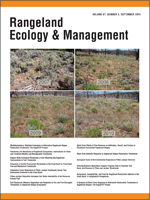Piñon (Pinus spp.) and juniper (Juniperus spp.) trees are reduced to restore native vegetation and avoid severe fires where they have expanded into sagebrush (Artemisia tridentata Nutt.) communities. However, what phase of tree infilling should treatments target to retain desirable understory cover and avoid weed dominance? Prescribed fire and tree felling were applied to 8–20-ha treatment plots at 11 sites across the Great Basin with a tree-shredding treatment also applied to four Utah sites. Treatments were applied across a tree infilling gradient as quantified by a covariate tree dominance index (TDI = tree cover/[tree shrub tall perennial grass cover]). Mixed model analysis of covariance indicated that treatment × covariate interactions were significant (P < 0.05) for most vegetation functional groups 3 yr after treatment. Shrub cover was most reduced with fire at any TDI or by mechanical treatment after infilling resulted in over 50% shrub cover loss (TDI > 0.4). Fire increased cheatgrass (Bromus tectorum L.) cover by an average of 4.2% for all values of TDI. Cutting or shredding trees generally produced similar responses and increased total perennial herbaceous and cheatgrass cover by an average of 10.2% and 3.8%, at TDIs ≥ 0.35 and ≥ 0.45. Cheatgrass cover estimated across the region was < 6% after treatment, but two warmer sites had high cheatgrass cover before (19.2% and 27.2%) and after tree reduction (26.6% and 50.4%). Fuel control treatments are viable management options for increasing understory cover across a range of sites and tree cover gradients, but should be accompanied by revegetation on warmer sites with depleted understories where cheatgrass is highly adapted. Shrub and perennial herbaceous cover can be maintained by mechanically treating at lower TDI. Perennial herbaceous cover is key for avoiding biotic and abiotic thresholds in this system through resisting weed dominance and erosion.
How to translate text using browser tools
1 September 2014
Understory Cover Responses to Piñon–Juniper Treatments Across Tree Dominance Gradients in the Great Basin
Bruce A. Roundy,
Richard F. Miller,
Robin J. Tausch,
Kert Young,
April Hulet,
Ben Rau,
Brad Jessop,
Jeanne C. Chambers,
Dennis Eggett
brush control
mastication
mechanical treatments
prescribed fire
resilience
state and transition
thresholds





